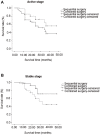Combined versus sequential penetrating keratoplasty and cataract surgery for herpes simplex keratitis: a retrospective study
- PMID: 37547606
- PMCID: PMC10403230
- DOI: 10.3389/fmed.2023.1190485
Combined versus sequential penetrating keratoplasty and cataract surgery for herpes simplex keratitis: a retrospective study
Abstract
Purpose: To compare the surgical outcomes of combined penetrating keratoplasty (PK) and cataract surgery with those of sequential surgery (cataract surgery after PK) for herpes simplex keratitis (HSK).
Methods: The medical records of consecutive patients diagnosed with HSK who underwent combined or sequential PK and cataract surgery in active and stable stages between June 2015 and June 2022 were reviewed retrospectively. Complications, graft survival, endothelial cell density (ECD), and final BCVA were compared and analyzed between both surgical methods in each stage.
Results: A total of 171 eyes of 171 patients were enrolled, including active stage (69 combined, 46 sequential) and stable stage (34 combined, 22 sequential). The average follow up was 24.2 ± 15.8 months (range, 3 months - 48 months). The final BCVA had obvious improvement and the postoperative ECD was not different in combined and sequential groups of each stage. In sequential group of active stage, 66.7% of persistent epithelial defects and 50% of HSK recurrence occurred within 3 months after cataract surgery; nevertheless, compared to that in sequential group, capsular rupture (p = 0.021), persistent epithelial defects (p = 0.027), and HSK recurrence (p = 0.035) occurred more frequently in combined group, leading to a lower graft survival rate (p = 0.045); at the last visit, 46.4 and 67.4% of grafts remained clear in combined and sequential groups, respectively. By contrary, 82.4 and 50.0% of grafts remained clear in stable stages of combined and sequential groups at the last visit, respectively, and a higher graft survival rate was observed in combined group (p = 0.030).
Conclusion: Although the postoperative ECD is not different between two surgical groups in each stage, sequential surgery in active stage of HSK seems to have advantages in less complications and higher graft survival rate, whereas combined surgery in stable stage has a better outcome than that in sequential surgery.
Keywords: cataract surgery; endothelial cell density; graft survival; herpes simplex keratitis; penetrating keratoplasty.
Copyright © 2023 Wang, Cheng, Yang, Li, Dong and Xie.
Conflict of interest statement
The authors declare that the research was conducted in the absence of any commercial or financial relationships that could be construed as a potential conflict of interest.
Figures



Similar articles
-
Long-term comparison of full-bed deep lamellar keratoplasty with penetrating keratoplasty in treating corneal leucoma caused by herpes simplex keratitis.Am J Ophthalmol. 2012 Feb;153(2):291-299.e2. doi: 10.1016/j.ajo.2011.07.020. Epub 2011 Oct 13. Am J Ophthalmol. 2012. PMID: 21996306
-
Efficacy of low-dose and long-term oral acyclovir therapy after penetrating keratoplasty for herpes simplex heratitis.Ocul Immunol Inflamm. 1999 Mar;7(1):51-60. doi: 10.1076/ocii.7.1.51.8113. Ocul Immunol Inflamm. 1999. PMID: 10410875 Clinical Trial.
-
Evidence in the prevention of the recurrence of herpes simplex and herpes zoster keratitis after eye surgery.Arch Soc Esp Oftalmol (Engl Ed). 2022 Mar;97(3):149-160. doi: 10.1016/j.oftale.2022.02.003. Epub 2022 Feb 19. Arch Soc Esp Oftalmol (Engl Ed). 2022. PMID: 35248396 Review.
-
Short-term results of acellular porcine corneal stroma keratoplasty for herpes simplex keratitis.Xenotransplantation. 2019 Jul;26(4):e12509. doi: 10.1111/xen.12509. Epub 2019 Apr 10. Xenotransplantation. 2019. PMID: 30968461 Clinical Trial.
-
Corneal Graft Success Rates in HSV Keratitis: A Systematic Review.Acta Medica (Hradec Kralove). 2020;63(4):150-158. doi: 10.14712/18059694.2020.57. Acta Medica (Hradec Kralove). 2020. PMID: 33355075
Cited by
-
Herpes simplex keratitis: A brief clinical overview.World J Virol. 2024 Mar 25;13(1):89934. doi: 10.5501/wjv.v13.i1.89934. World J Virol. 2024. PMID: 38616855 Free PMC article. Review.
References
LinkOut - more resources
Full Text Sources

